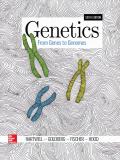
Concept explainers
a.
To draw:
The recombinant plasmid that indicates the order of the four components and their arrangement in relation to the plasmid vector.
Introduction:
Erythropoietin, which is a human protein stimulates the production of red blood cells. The idea is to make a bacterium that produces this protein, and this recombinant bacterium can be used for the treatment of anemia patients.
b.
To determine:
The element that encodes the ribosome binding site for the mRNA making the fusion protein.
Introduction:
The recombinant plasmid was made to contain coding sequence for human erythropoietin, the regulatory sequence of the lac operon, a sequence encoding E.coli maltose-binding protein, and a sequence encoding a series of five amino acids. These sequences were transformed in the recombinant plasmid to induce the expression of a tagged fusion protein N MBP-DDDDK-erythropoietin C.
c.
To determine:
The elements out of given four that should be placed in the same reading frame with respect to each other.
Introduction:
The four elements present in the recombinant DNA molecule include coding sequence for erythropoietin, a sequence encoding the maltose-binding protein in E.coli and a series of five amino acids, and the regulatory sequence for lac operon.
d.
To determine:
Whether the erythropoietin coding sequences can be obtained from a human genomic DNA or from a human cDNA clone.
Introduction:
The creation of cDNA clones occurs in three major steps known as the synthesis, cloning, and validation. The cDNA clones contain open reading frames and untranslated regions.
e.
To determine:
The compound that could be used for inducing expression of the fusion protein and giving a reason about adding the compound to the medium before seeding with E.coli cells or after reaching the population of cells to high density.
Introduction:
The fusion protein that has to be made in the recombinant E.coli producing erythropoietin protein is N MBP-DDDDK-erythropoietin C.
f.
To determine:
The process by which fusion protein can be purified away from the other E.coli proteins.
Introduction:
The cells that express the fusion protein also contain many other E.coli proteins. It is considered to be important to purify the drugs away from the contaminants. It is known that MBP tightly binds to the sugar maltose and this maltose can be attached to an insoluble resin.
g.
To determine:
The way by which enterokinase can be used to separate the erythropoietin away from the rest of the fusion protein and then perform the purification of the desired pharmaceutical.
Introduction:
It is been studied that the human erythropoietin should not be attached to any other amino acid sequence. So, a protein known as enterokinase is used to cleave the proteins just C-terminal to DDDDK.
Trending nowThis is a popular solution!

Chapter 16 Solutions
EBK GENETICS: FROM GENES TO GENOMES
- please fill in missing parts , thank youarrow_forwardplease draw in the answers, thank youarrow_forwarda. On this first grid, assume that the DNA and RNA templates are read left to right. DNA DNA mRNA codon tRNA anticodon polypeptide _strand strand C с A T G A U G C A TRP b. Now do this AGAIN assuming that the DNA and RNA templates are read right to left. DNA DNA strand strand C mRNA codon tRNA anticodon polypeptide 0 A T G A U G с A TRParrow_forward
- Please identify the curve shown below. What does this curve represent? Please identify A, B, C, D, and E (the orange oval). What is occurring in these regions?arrow_forwardPlease identify the test shown here. 1) What is the test? 2) What does the test indicate? How is it performed? What is CX? 3) Why might the test be performed in a clinical setting? GEN CZ CX CPZ PTZ CACarrow_forwardDetermine how much ATP would a cell produce when using fermentation of a 50 mM glucose solution?arrow_forward
- Determine how much ATP would a cell produce when using aerobic respiration of a 7 mM glucose solution?arrow_forwardDetermine how much ATP would a cell produce when using aerobic respiration to degrade one small protein molecule into 12 molecules of malic acid, how many ATP would that cell make? Malic acid is an intermediate in the Krebs cycle. Assume there is no other carbon source and no acetyl-CoA.arrow_forwardIdentify each of the major endocrine glandsarrow_forward
 Biology (MindTap Course List)BiologyISBN:9781337392938Author:Eldra Solomon, Charles Martin, Diana W. Martin, Linda R. BergPublisher:Cengage Learning
Biology (MindTap Course List)BiologyISBN:9781337392938Author:Eldra Solomon, Charles Martin, Diana W. Martin, Linda R. BergPublisher:Cengage Learning Human Heredity: Principles and Issues (MindTap Co...BiologyISBN:9781305251052Author:Michael CummingsPublisher:Cengage Learning
Human Heredity: Principles and Issues (MindTap Co...BiologyISBN:9781305251052Author:Michael CummingsPublisher:Cengage Learning Biology: The Dynamic Science (MindTap Course List)BiologyISBN:9781305389892Author:Peter J. Russell, Paul E. Hertz, Beverly McMillanPublisher:Cengage Learning
Biology: The Dynamic Science (MindTap Course List)BiologyISBN:9781305389892Author:Peter J. Russell, Paul E. Hertz, Beverly McMillanPublisher:Cengage Learning Human Biology (MindTap Course List)BiologyISBN:9781305112100Author:Cecie Starr, Beverly McMillanPublisher:Cengage Learning
Human Biology (MindTap Course List)BiologyISBN:9781305112100Author:Cecie Starr, Beverly McMillanPublisher:Cengage Learning Concepts of BiologyBiologyISBN:9781938168116Author:Samantha Fowler, Rebecca Roush, James WisePublisher:OpenStax College
Concepts of BiologyBiologyISBN:9781938168116Author:Samantha Fowler, Rebecca Roush, James WisePublisher:OpenStax College Biology Today and Tomorrow without Physiology (Mi...BiologyISBN:9781305117396Author:Cecie Starr, Christine Evers, Lisa StarrPublisher:Cengage Learning
Biology Today and Tomorrow without Physiology (Mi...BiologyISBN:9781305117396Author:Cecie Starr, Christine Evers, Lisa StarrPublisher:Cengage Learning





